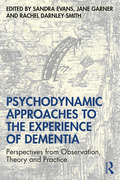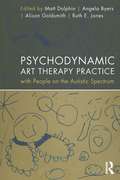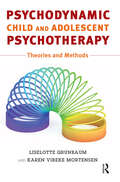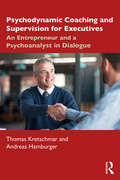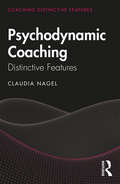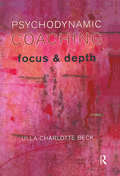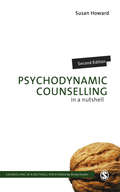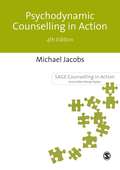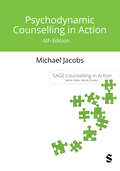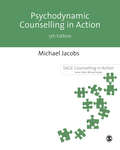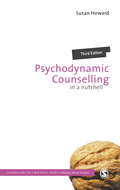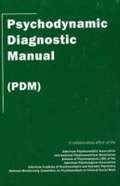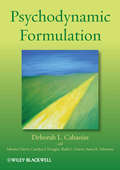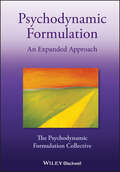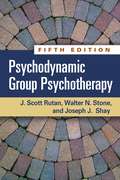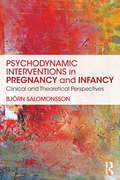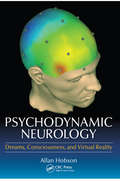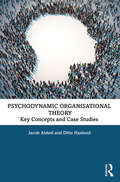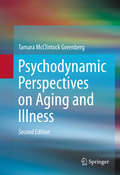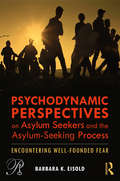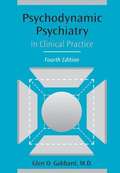- Table View
- List View
Psychodynamic Approaches for Treatment of Drug Abuse and Addiction: Theory and Treatment
by David PotikThis book provides clinicians and students with insights on the use of psychodynamic therapy to treat drug abuse and addiction, combining theory with clinical case material. The perspectives of analysts such as Abraham, Rado, Zimmel, Tibout, Wurmser, Khanzian, Krystal and McDougall are reviewed alongside original and more recent conceptualizations of drug addiction and recovery based on Kleinian, Winnicottian and Kohutian ideas. The case material deals with clinical phenomena that characterize working with this complex population, such as intense projective identification, countertransference difficulties and relapses. The theoretical analysis covers a range of concepts, such as John Steiner's psychic shelters and Betty Joseph's near-death-addiction, which are yet to be fully explored in the context of addiction. Prevalent topics in the addiction field, such as the reward system, the cycle of change and the 12-step program, are also discussed in relation to psychodynamic theory and practice. Written by an experienced therapist, Psychodynamic Approaches for Treatment of Drug Abuse and Addiction is useful reading for anyone looking to understand how psychodynamic thought is applicable in the treatment of drug abuse and addiction. It may also be of some relevance to those working on treating alcohol use disorders and behavioral addictions.
Psychodynamic Approaches to the Experience of Dementia: Perspectives from Observation, Theory and Practice
by Rachel Darnley-Smith Sandra Evans Jane GarnerPsychodynamic Approaches to the Experience of Dementia: Perspectives from Observation, Theory and Practice demonstrates the impact of healthcare approaches that take into account not only the practical needs but also the emotional experience of the patient, their partners, families and friends, lay carers and professional staff. Currently there is no cure for dementia, but the psychosocial and therapeutic approaches described in this volume have appeared to help people, both patients and carers, feel more contained and less lonely and isolated. Psychoanalytic theory provides a disciplined way of thinking about the internal world of an individual and their relationships. Each author provides their own commentary on the personal and interpersonal effects of dementia, endeavouring to understand behaviours and emotions which may otherwise seem incomprehensible. The subject is approached from a psychodynamic perspective, considering the unconscious, previous and current experiences and relationships, including those between patients and staff. Psychodynamic Approaches to the Experience of Dementia illustrates the practical and theoretical thinking of clinicians from a wide range of disciplines who are engaged in the care of people in late life with a diagnosis of dementia. It will be essential reading for mental health and health professionals in practice and training in the field of dementia.
Psychodynamic Art Therapy Practice with People on the Autistic Spectrum: With People On The Autistic Spectrum
by Matt Dolphin Angela Byers Alison Goldsmith Ruth E. JonesPsychodynamic Art Therapy Practice with People on the Autistic Spectrum offers a valuable counterbalance to the phenomenological, cognitive and behavioural theories that currently prevail in the wider field of practice and research. The result of a decade of work by a group of highly experienced art therapists, this book presents eight frank and compelling accounts of art therapy with either adults or children with autism, supported by a discussion of the relevant theory. The book begins with an overview of the theoretical context and the subsequent chapters give varied accounts of practitioners’ experiences structured in a loose developmental arc, reflecting issues that may arise in different settings and at various stages of therapy. Each is followed by an afterword which describes the author’s reflections in the light of their subsequent knowledge and experience. The conclusion brings together some of the common threads arising from their encounters and considers how these might be relevant to current and continuing art therapy practice in the field of autism. Psychodynamic Art Therapy Practice with People on the Autistic Spectrum is a thoughtful consideration of where art therapy meets autism and the particular challenges that arise in the encounter between the autistic client and the therapist. Presenting honest reflections arising from lived encounters and highlighting general principles and experiences, this book aims to orient other practitioners who work with people on the autistic spectrum, in particular art therapists and art therapy trainees.
Psychodynamic Child and Adolescent Psychotherapy: Theories and Methods
by Karen Vibeke Mortensen Liselotte GrünbaumPsychodynamic Child and Adolescent Psychotherapy is both a textbook and book of reference for all child and adolescent psychotherapists. It addresses both novices, who need to learn the theories and methods of the work, and also experienced psychotherapists, who want to expand their knowledge, at the same time getting a readily-accessible update and revival of the many ways in which psychodynamic child and adolescent psychotherapy enters into contemporary practice. The book offers a clear, methodologically precise and updated introduction to the theories, methods and practice of the field. The authors demonstrate through practical examples what psychodynamic child and adolescent psychotherapy is, and how a psychotherapy can be planned and carried out, expounding the necessary preconditions, settings and methods. A personal understanding of the complexity of the therapeutic relationship is presented together with an elucidation of drawings and symbolic play, parallel work with parents, and the special conditions for work with adolescents. A special section deals with the meaning of time, beginnings, endings, and breaks in psychotherapy, followed by a part about the methodological adaptations necessary for psychotherapy with children and adolescents suffering from maltreatment and complex trauma. Psychodynamic Child and Adolescent Psychotherapy ends with a description of the present state of research in the field.
Psychodynamic Coaching and Supervision for Executives: An Entrepreneur and a Psychoanalyst in Dialogue
by Andreas Hamburger Thomas KretschmarThomas Kretschmar and Andreas Hamburger provide an important overview of psychodynamic work in companies, presenting different viewpoints and explaining key psychoanalytic terms and techniques for coaching and supervision. Written in the form of a dialog between Kretschmar, an entrepreneur, and Hamburger, a psychoanalyst, the book provides unique insight into psychodynamic coaching and supervision. Psychodynamic Coaching and Supervision for Executives begins with an overview of coaching, psychodynamic approaches, the unconscious and relevant psychoanalytic theory. Kretschmar and Hamburger then consider Operationalized Psychodynamic Diagnosis (OPD) in business, assess current research into coaching and supervision and present a selection of key case studies. At the end of each chapter, the authors compare their positions, giving important contextual information, exploring objections, complications and improvements, and providing a precise summary of the topic. This book will be an illuminating guide for therapists and professionals who wish to learn how psychoanalytic theory and practice can be used for coaching, counseling and supervision in an organizational context.
Psychodynamic Coaching: Distinctive Features (Coaching Distinctive Features)
by Claudia NagelIn Psychodynamic Coaching: Distinctive Features, Claudia Nagel presents a comprehensive overview of the unique features of psychodynamic coaching. As leaders and managers acknowledge the need to understand themselves and their context by looking underneath the surface to improve their decision-making, psychodynamic approaches offer unique insight. Psychodynamic Coaching: Distinctive Features covers not only the major theory but also the practice of coaching, giving guidance from beginning to end of the client relationship. Constructive, holistic and accessible, it demonstrates the impact and dynamics of the unconscious whilst illustrating the power of understanding human behaviour in the complexity of the modern world. With a focus on emotions and relationships in supporting modern leaders adapting to organsational challenges, this book will be an invaluable tool for coaches of all backgrounds, academics and students of coaching and organisational behaviour, and also clinicians. It will also be a key resource for senior leaders for their own personal growth.
Psychodynamic Coaching: Focus and Depth
by Ulla Charlotte BeckIn a postmodern age we all need a room of our own. A room - or space - where we can explore and reflect on how the rapidly changing world affects us. A room where it is possible to get a feeling of who we are, and wish to be, in the middle of the buzz of our everyday lives. Where it is possible to explore our challenges and possibilities and thus become a more robust human being. Where we can think of our relationships and interactions. Where we can have a break and some relief and where we can summon the energy to act - or not to act - in our lives. Coaching is way of providing the space for such thoughts, reflections, and insights into our possibilities. Most of the different coaching methods do not adhere to a specific psychological theory. However, in this book you will meet a coaching method that is based on a specific theory - psychodynamics.
Psychodynamic Counselling (Counselling in a Nutshell)
by Susan HowardPsychodynamic Counselling in a Nutshell explains in clear, jargon-free style, the concepts at the heart of the psychodynamic approach, and, drawing on case material, describes the therapeutic practice which rests on those ideas. Assuming no previous knowledge of the subject, the book introduces: - the history of the approach, - the key main concepts, and - practical techniques used by practitioners In the first chapter, the author introduces a client, John, whose case is revisited throughout the book, connecting together theory and practice for the reader. This new and revised edition also now includes new material on supervision and ethics, on Freud and Jung, and on outcome research and the most recent developments in the field. Psychodynamic Counselling in a Nutshell is the ideal place to start for anyone reading about the psychodynamic approach for the first time.
Psychodynamic Counselling in Action
by Michael JacobsSAGE celebrated the 20th Anniversary of the Counselling in Action in November 2008. To view the video - click here ------------------------------------------------------------- `One of the most reliable (and readable) guides to what is involved in counselling that stems from the various psychoanalytic traditions. Jacobs' well-organized and comprehensive summaries of the main theories and his illustrations of psychodynamic counselling drawn from his own work will inspire students and trainees on counselling and therapy courses. They will also interest (and create envy) in more experienced readers' - Professor Andrew Samuels, Centre for Psychoanalytic Studies, University of Essex Psychodynamic Counselling in Action is widely regarded as the most accessible introduction to the psychodynamic approach, making it ideal for readers who are new to the subject. In this Third Edition of his bestselling book, Michael Jacobs describes the psychodynamic counselling process from initial meeting right through to the end of the relationship. He sets out the main theory and principles involved in psychodynamic work and - through two case studies - a man and a woman - shows how these can be applied creatively and effectively within the process. In updating the book, he has also extended his discussion of defences and the therapeutic relationship. Psychodynamic Counselling in Action has been instrumental in training many thousands of counsellors. Now in its Third Edition, it continues to be the essential text for a wide range of courses.
Psychodynamic Counselling in Action (Counselling in Action series)
by Michael JacobsThis classic text demonstrates psychodynamic theory and practices across the counselling process beginning – middle - end. This revised sixth edition includes a new preface, updated further reading sections and a new chapter covering contemporary issues including online working, the application of a social justice and DEI agenda within the field of psychodynamic theory and practice. Counselling in Action is a bestselling series of practical introductions designed for trainees and practitioners. Each book introduces one of the main theoretical approaches and provides a guide to the process of counselling from beginning to end. Covering theory and practice, they are trusted companions for many courses in counselling and psychotherapy and other professions such as nursing, social work and teaching.
Psychodynamic Counselling in Action (Counselling in Action series)
by Michael JacobsThis classic text demonstrates psychodynamic theory and practices across the counselling process beginning – middle - end. This revised sixth edition includes a new preface, updated further reading sections and a new chapter covering contemporary issues including online working, the application of a social justice and DEI agenda within the field of psychodynamic theory and practice. Counselling in Action is a bestselling series of practical introductions designed for trainees and practitioners. Each book introduces one of the main theoretical approaches and provides a guide to the process of counselling from beginning to end. Covering theory and practice, they are trusted companions for many courses in counselling and psychotherapy and other professions such as nursing, social work and teaching.
Psychodynamic Counselling in Action (Counselling in Action)
by Michael JacobsThis substantially revised fifth edition of a classic text includes an updated preface, new content on the therapeutic relationship, substantially revised chapters on the middle phase of counselling and reflections on the influence of other modalities and shared aspects of practice across approaches. Each chapter now includes an annotated Further Reading section to help deepen knowledge and reinforce learning of key aspects of the counselling process.
Psychodynamic Counselling in Action (Counselling in Action)
by Michael JacobsThis substantially revised fifth edition of a classic text includes an updated preface, new content on the therapeutic relationship, substantially revised chapters on the middle phase of counselling and reflections on the influence of other modalities and shared aspects of practice across approaches. Each chapter now includes an annotated Further Reading section to help deepen knowledge and reinforce learning of key aspects of the counselling process.
Psychodynamic Counselling in a Nutshell (Counselling in a Nutshell)
by Susan HowardSusan Howard explains in a clear, jargon-free style, the concepts at the heart of the psychodynamic approach, and, drawing on case material, describes the therapeutic practice which rests on those ideas. Assuming no previous knowledge of the subject, the book introduces: the history of the approach main key concepts practical techniques used by practitioners In the first chapter, you are introduced to a client, Layla, whose case you'll revisit throughout the book, helping you connect theory and practice. This edition also includes new material on working with diversity and difference, neuroscience and extended discussion on ethics.
Psychodynamic Counselling in a Nutshell (Counselling in a Nutshell)
by Susan HowardSusan Howard explains in a clear, jargon-free style, the concepts at the heart of the psychodynamic approach, and, drawing on case material, describes the therapeutic practice which rests on those ideas. Assuming no previous knowledge of the subject, the book introduces: the history of the approach main key concepts practical techniques used by practitioners In the first chapter, you are introduced to a client, Layla, whose case you'll revisit throughout the book, helping you connect theory and practice. This edition also includes new material on working with diversity and difference, neuroscience and extended discussion on ethics.
Psychodynamic Diagnostic Manual
by Alliance of Psychoanalytic OrganizationsThis manual is based on current neuroscience and treatment outcome studies that demonstrate the importance of focusing on the full range and depth of emotional and social functioning. Beginning with a classification of the spectrum of personality patterns and disorders found in individuals and then describing a profile of mental functioning that permits a clinician to look in detail at each of the patient's capacities, the entries include a description of the patient's symptoms with a focus on the patient's internal experiences as well as surface behaviors. Intended to expand on the DSM (Diagnostic and Statistical Manual of Mental Disorders)and ICD (International Statistical Classification of Diseases and Related Health Problems) efforts in cataloging the symptoms and behaviors of mental health patients, this manual opens the door to a fuller understanding of the functioning of the mind, brain, and their development.
Psychodynamic Formulation
by Ruth Graver Anna R. Schwartz Sabrina Cherry Deborah L. Cabaniss Carolyn J. DouglasHow do our patients come to be the way they are? What forces shape their conscious and unconscious thoughts and feelings? How can we use this information to best help them? Constructing psychodynamic formulations is one of the best ways for mental health professionals to answer questions like these. It can help clinicians in all mental health setting understand their patients, set treatment goals, choose therapeutic strategies, construct meaningful interventions and conduct treatment.Despite the centrality of psychodynamic formulation to our work with patients, few students are taught how to construct them in a clear systematic way. This book offers students and practitioners from all fields of mental health a clear, practical, operationalized method for constructing psychodynamic formulations, with an emphasis on the following steps: DESCRIBING problems and patternsREVIEWING the developmental historyLINKING problems and patterns to history using organizing ideas about development.The unique, up-to-date perspective of this book integrates psychodynamic theories with ideas about the role of genetics, trauma, and early cognitive and emotional difficulties on development to help clinicians develop effective formulations.Psychodynamic Formulation is written in the same clear, concise style of Psychodynamic Psychotherapy: A Clinical Manual (Wiley 2011). It is reader friendly, full of useful examples, eminently practical, suitable for either classroom or individual use, and applicable for all mental health professionals. It can stand alone or be used as a companion volume to the Clinical Manual.
Psychodynamic Formulation: An Expanded Approach
by The Psychodynamic Formulation CollectivePsychodynamic Formulation A leading text for psychodynamic clinicians and practitioners Psychodynamic Formulation: An Expanded Approach delivers an exceptional exploration of psychodynamic explanations and hypotheses that seek to explain how a person’s conscious and unconscious thoughts and feelings may have developed and may be causing or contributing to the challenges they face. This latest edition of the leading reference includes a refreshed and reinvigorated emphasis on the impacts of culture and society, as well as the importance of diversity and inclusion, on psychodynamic formulation. It puts new focus on lived experience, including trauma, and on how clinical bias can contribute to the perpetuation of trauma. In addition to newly included activities and exercises, readers will find: A practical, step-by-step guide to collaboratively creating psychodynamic formulations Comprehensive discussions about how what we’re born with and environmental influences contribute to development Suggestions for using psychodynamic formulations in many clinical settings, including acute care and psychopharmacologic treatment An educator’s guide to teaching psychodynamic formulation Perfect for mental health practitioners with a professional or personal interest in psychodynamics/psychoanalysis, Psychodynamic Formulation: An Expanded Approach will earn a place in the libraries of trainees in all mental health fields.
Psychodynamic Group Psychotherapy, Fifth Edition
by Walter N. Stone Joseph J. Shay J. Scott RutanRegarded as the definitive practitioner reference and text, this accessible work addresses all aspects of setting up therapy groups and making them work. A wealth of clinical material illustrates the components of effective group therapy and the mechanisms and processes of change. Practical topics discussed include patient selection and preparation, leadership issues, communication of affect in groups, dealing with "difficult" patients, time-limited groups, and facilitating successful terminations. A chapter-length case example with commentary from each author brings an entire group session to life and explores ways to handle common dilemmas. New to This Edition *Incorporates current theory (psychodynamic and interpersonal), which is grounded in clinical and neurobiological research. *Every chapter revised and updated. *Chapter-length case example is entirely new. *Chapter on Frequently Asked Questions includes many new issues.
Psychodynamic Interventions in Pregnancy and Infancy: Clinical and Theoretical Perspectives
by Björn SalomonssonPsychodynamic Interventions in Pregnancy and Infancy builds on Björn Salomonsson’s experiences as a psychoanalytic consultant working with parents and their babies. Emotional problems during the perinatal stages can arise and be observed and addressed by a skilled midwife, nurse or health visitor. Salomonsson has developed a method combining nurse supervision and therapeutic consultations which has lowered the thresholds for parents to come and talk with him. The brief consultations concern pregnant women, mother and baby, husband and wife, toddler and parent. The theoretical framework is psychoanalytic, but the mode of work is eclectic and adapted to the family’s situation and its members’ motivation. This book details such work, which can be applied globally; perinatal psychotherapy integrated with ordinary medical health care. It also explains how psychotherapy can be made more accessible to a larger population. Via detailed case presentations, the author takes the reader through pregnancy, childbirth and the first few years of life. He also brings in research studies emphasizing the importance of early interventions, with the aim of providing therapists with arguments for such work in everyday family health care. To further substantiate such arguments, the book ends with theoretical chapters and, finally, the author’s vision of the future of a perinatal health care that integrates medical and psychological perspectives. Psychodynamic Interventions in Pregnancy and Infancy will appeal to all psychoanalysts and psychoanalytic psychotherapists working in this area, as well as clinical psychologists, clinical social workers and medical personnel working with parents and infants.
Psychodynamic Neurology: Dreams, Consciousness, and Virtual Reality
by Allan HobsonPsychodynamic Neurology: Dreams, Consciousness, and Virtual Realty presents a novel way of thinking about the value of dreaming, based in solid comprehension of scientific research on sleep and dreams, but with deep understanding of psychoanalytic and other interpretations of dreams. <P><P>This book: <li>Surveys the remarkable history of sleep research over the past few decades <li>Examines the neurobiology of sleep and its implications for consciousness and well-being <li>Addresses the nature of waking and dreaming consciousness and how they are deeply related <li>Presents the neurogenesis, function, and clinical importance of a brain-based dream theory <P><P>Our dreams are a mixture of anticipated virtual as well as remembered real experience. This book tells the story of how neuroscience has helped us reach this startling and exciting conclusion and how the new scientific model builds upon and departs from the dream theories of the past.
Psychodynamic Organisational Theory: Key Concepts and Case Studies
by Jacob Alsted Ditte HaslundOn the surface, people go to work and come home again. They sometimes manage people while most are managed themselves. But beneath the function and structures of the work itself, a whole range of emotions affects the success of the relationship between employee and manager and ultimately the organisation they both belong to. Psychodynamic Organisational Theory: Key Concepts and Cases provides a comprehensive but accessible introduction to this fascinating field of study. Featuring case vignettes which bring the various concepts to life, the book is divided into four parts. Part I looks at how the individual relates to the organisation and the unconscious energies they bring, while Part II examines group dynamics and how they affect productivity, including a chapter on meetings. Part III explores the realm of leadership and what roles a manager can play in managing their staff, while Part IV introduces the idea of personality and describes how the manager’s personality influences management dynamics as well as the wider organisational culture. Central to the book, as well as the idea that organisational phenomena are often unconscious, is the understanding that relationships are always reciprocal. Through complex psychological dynamics manager and employee influence and change each other during the process of managing and being managed. This text will be essential reading for students and scholars of leadership, HRM, and organizational psychology, as well as consultants and managers looking for practical insights into how human relationships affect the success of every organisation.
Psychodynamic Perspectives on Aging and Illness
by Tamara Mcclintock GreenbergMore than ever, the aging process is recognized as carrying a special set of emotional challenges-especially when acute or chronic medical conditions are involved. In this light, Psychodynamic Perspectives on Aging and Illness presents a fresh, contemporary application of psychodynamic theory, addressing the complex issues surrounding declining health. Informed by the spectrum of psychodynamic thought from self, relational, and classical theories, this forward looking volume offers more modern interpretations of theory, and techniques for working with a growing, complicated, but surprisingly resilient population. It illuminates how to enhance the therapeutic relationship in key areas such as addressing body- and self-image issues, approach sensitive topics, and understand the disconnect that can occur between medical patients and the often impersonal, technology-driven health care system. At the same time, the author cogently argues for pluralism in a therapeutic approach that is frequently threatened by forces both within and outside the field. Among the topics covered: Medical illness as trauma. Idealization and the culture of medicine. Normative and pathological narcissism in the ill and/or aging patient. Noncompliant and self-destructive behaviors. Transference and countertransference issues. Psychotherapy with cognitively impaired adults. Grief, loss, and hope. Expanding on what we know and candid about what we don't, Psychodynamic Perspectives on Aging and Illness offers mental health researchers and practitioners an insightful framework for improving the lives of older patients.
Psychodynamic Perspectives on Asylum Seekers and the Asylum-Seeking Process: Encountering Well-Founded Fear (Psychoanalysis in a New Key Book Series)
by Barbara K. EisoldPsychodynamic Perspectives on Asylum Seekers and the Asylum-Seeking Process looks at the psychosocial assessment of asylum seekers from three perspectives: forensic, psychodynamic, and political and then attempts to better understand, from a psychodynamic perspective, differences in the historical/motivational routes of asylum seekers themselves. Barbara Eisold begins in Chapter One by exploring the unique evaluation relationship of psychosocial assessment and the striking will to survive of the asylum seekers that it puts into focus, using a psychodynamic lens. The forensic value of psychosocial assessment and its potential as both a political and a therapeutic tool are then described. Chapter Two describes individuals, who, by background and personal characteristics, shared a profound desire to protest, gravely compromising their survival at home and forcing them to seek asylum elsewhere. Chapter Three discusses women who have suffered female genital mutilation and includes a discussion of the development of strong personal agency in one case. Chapter Four describes abused women from Central America forced to flee from femicide. The evolution of femicide is explored, including the development of honor-bound machismo and the wide-spread disregard of law. The hold men have on women is then examined from a psychodynamic perspective. Psychodynamic Perspectives on Asylum Seekers and the Asylum-Seeking Process will be of great interest to psychoanalysts, psychoanalytic psychotherapists, and all mental health professionals working with asylum seekers.
Psychodynamic Psychiatry in Clinical Practice (4th edition)
by Glen O. GabbardThe book introduces the basic principles of psychodynamic psychiatry and the four fundamental theoretical frameworks derived from psychoanalytic theory: ego psychology, object relations theory, self psychology, and attachment theory.

